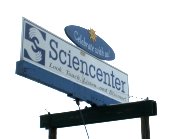- By Teresa Bell
- Around Town
 Print
Print  The Association of Science-Technology Centers in Washington, D.C., has awarded the Sciencenter the 2013 Roy L. Shafer Leading Edge Award for Innovative Business Practice in recognition of its Human Resources Toolkit on MuseumTools.org.
The Association of Science-Technology Centers in Washington, D.C., has awarded the Sciencenter the 2013 Roy L. Shafer Leading Edge Award for Innovative Business Practice in recognition of its Human Resources Toolkit on MuseumTools.org.This prestigious international award, made to one museum each year, cited the Sciencenter’s new website MuseumTools.org, an online toolkit of high-impact HR resources for museums and other non-profits to freely download and customize. The toolkit contains four dozen procedures, templates, and tools that the Sciencenter developed. Focus areas include high impact hiring, orientation for long-term success, staff handbooks, managing teams to reach their potential, planning and evaluation, and collaboration.
According to the Association of Science-Technology Centers CEO Anthony (Bud) Rock, “The Sciencenter’s HR Toolkit benefits museums worldwide. With the set of first-class tools available at MuseumTools.org, museums can now spend less time creating their own HR procedures and more time educating audiences about science."
The Association of Science-Technology Centers (ASTC) is a global organization of more than 640 science centers and museums in 47 countries dedicated to increase awareness of the valuable contributions its members make to their communities and the field of informal STEM learning. This ASTC award program recognizes extraordinary accomplishments and contributions to the field made by large and small museums of science around the world. The Leading Edge Awards are selected by an international jury from ASTC member museums.
This is the third time the Sciencenter has received this award, making it the only museum in the world to have been recognized for innovation in business practice three times. The Sciencenter’s first Leading Edge Award was received in 2005 in recognition of the Sciencenter’s "Wall of Inspiration" exhibition, and the second in 2009 for its Sustainability Initiative.
According to Charlie Trautmann, executive director of the Sciencenter, “As we began to celebrate our 30th anniversary year, we were looking for a way to expand our impact on science learning globally. By sharing these well-honed procedures online, the Sciencenter is helping to improve operations in hundreds of museums and improve the learning experience for tens of millions of guests who visit them annually."
v9i26



